 |
||
|
||
| ||
500 GB, Serial ATA II, and 16 MB Buffer,
|
|||||||||||||||||||||||||||||||||||||||||||||||||||||||||||||||||||||||||||||||||||||||||||||||||||||||||||||||||||||||||||||||||||||||||||||||||||||||||||||||||||||||||||||||||||||||||||||||||||||||||||||||||||||||||||||||||||||||||||||||||||||||||||||||||||||||||||||||||||||||||||||||||||||||||||||||||||||||||||||||||||||||||||||||||||||||||
| Series | T7K250 | T7K500 | 7K500 E7K500 |
7K400 |
| In-house name of a series | Vancouver 4 | Vancouver 5 | Kurofune 2 | Kurofune |
| Capacity of models, GB | 250 160 |
500 400 320 (300) 250 |
500 |
400 |
| Number of heads/platters | 4/2 3/2 |
6/3 6/3 4/2 4/2 |
10/5 |
10/5 |
| Recording density, GB per platter (Gbit per inch) | 125 (92,1) |
160 (118 max) |
100 (76) |
80 (62) |
| Maximum media transfer rate, Mbit/s | 843 |
998 |
817 |
757 |
| Media transfer rate, MB/s | 67,8-32,9 (Zone 0-29) |
Depends on a model, see below |
64,8-31 (Zone 0-29) |
61,4-29,8 (Zone 0-29) |
| Seek time average, (read, typical, ms, including command overhead) | 8.5 |
8.8 (OEM spec) |
8.5 |
8.5 |
| Logical interface | ATA-7 |
ATA-7 |
ATA-7 |
ATA-7 |
| Physical interface | Serial ATA II 3Gb/s or UltraATA/133 |
Serial ATA 1.0 or UATA/133 |
||
| Interface transfer rate, MB/s | 300, 150 (sata), and 133 (pata) |
133 (pata) and 150 (sata) |
||
| Data buffer, MB | 8 |
16 (sata) or 8 (sata, pata) |
16 (sata) or 8 (pata) |
8 |
| Firmware zone in the buffer, KB | 270 |
270 |
271 |
271 |
| Start/stops | 50,000 |
50,000 |
50,000 |
50,000 |
| Idle acoustic noise, dBA, type. (max.) | 28 (32) |
30 (34) (3disk) 28 (32) (2disk) |
31 (35) |
31 (35) |
| Seek acoustic noise, dBA, type. (max.) | 34 (37) Quiet seek: 29 (33) |
32 (35) (3disk) 30 (33) (2disk) Quiet seek: 31 (35) (3disk) 29 (33) (2disk) |
35 (38) Quiet seek: 33 (36) |
35 (38) Quiet seek: 33 (36) |
| Operating shock resistance (2ms), G | 55 |
70 |
55 |
55 |
| Non-operating shock resistance (2ms), G | 350 |
350 (2 platters) 300 (3 platters) |
225 |
225 |
| Temperature, C, on(off) | +5...55 (-40...+65) |
+0...60 (-40...+65) |
+5...55 (-40...+65) |
|
| Power consumption, Watt: spin-up idle |
28.5 (1.88A@12V) 5.2(pata)-6.2(sata) |
30 (2A@12V) 5-6(pata)/ 6-7(sata) — depending on a number of platters |
30 (2A@12V) 9.0(pata)/ 9.6(sata) |
30 (2A@12V) 9.0(pata)/ 9.6(sata) |
| Max weight (g) | 640 |
640 |
700 |
700 |
| Link to OEM specifications (PDF) | ||||
The main advantage of the T7K500 is certainly its increased recording density and associated performance perks. The linear read rate in top T7K500 models has grown by 22% versus 7K500 and by 18% versus the 250 GB T7K250 model. Recording density in Vancouver 5 has grown by 28% versus Vancouver 4, and over 1.5 times versus Kurofune 2. That is the linear density along tracks (BPI) has grown by 13.6% and 21% correspondingly. And the track density (TPI) — by 12.5% and 29% correspondingly (see the data from Table 2 below). And we can draw a conclusion that Hitachi has proportionally reduced length and width of magnetic bits on platters of the latest models. But manufacturers more often prefer the latter solution (that is the linear transfer rate grows slower that the root of recording density growth).
The top T7K500 model contains up to 1500 data sectors at each outer track, that is their data capacity reaches 750 KB (one cylinder — 4500 KB). At the same time bit length is less than 30 nm, and the gap between centers of neighboring tracks (bit width) is less than 190 nm. By the way, it conforms well with the efficient size of gates in modern field-effect transistors, manufactured by the 65 nm process technology. Nevertheless, even 118 Gbit per inch is lower than the recording density in the recently launched 2.5" drives with perpendicular magnetic recording, where the recoding density reaches 131.5 Gbit per inch. However, the latter models offer lower spindle rotational speed.
So, judging by specifications, the new T7K500 models with significantly increased capacity of their platters also got much higher linear transfer rates (reading and writing). But it comes at the cost of worse average seek time: T7K500 OEM specifications report about 8.8 ms (including command overhead), while direct predecessors, including 7K500, T7K250 and 7K400, offer only 8.5 ms (or typical 8.5 ms and 8.2 ms without command overhead).
In this connection it should be noted that the reduced Command Overhead (mentioned in the T7K250 review) from 0.5 ms for old Hitachi drives to 0.3 ms for T7K250 in the T7K500 series got no further support: Command overhead for "Read (cache not hit) (from Command Write to Seek Start)" and "Seek (from Command Write to Seek Start)" in Vancouver 5 equals 0.5 ms again (typical value). The same concerns Deskstar 7K500, 7K250, 7K400. But T7K250 offered 0.3 ms (even though it used the same controller chip, see above). Fortunately, other seek time parameters of all these series are practically the same. Recall that Command overhead is defined as the time required from the time the command is written into the command register by a host to the assertion of DRQ (Data Request) for the first data byte of a READ command when the requested data is not in the buffer excluding Physical seek time and Latency. It's arbitrarily the seek time measured by a system (host), had the mechanical seek process been instantaneous. :) If it deteriorates by a couple of tenths of millisecond, it can contribute to a HDD performance drop even for movements between neighboring tracks. By the way, the average seek time for writing in these Hitachi drives is 1 ms as high as for reading. According to specifications, its typical value in Quiet Seek mode is 14.0 ms for reading (according to specifications, this value for 7K500 and T7K250 is 19.5 ms, though it's lower in practice).
The drives support seek acoustic management through the AAM register (user can control it via such popular utilities as Hitachi FeatureTool, HDDLife, etc). Fast Seek mode was set by default (AAM disabled, see the HDD Life screenshot on the left), but we also tested these drives in Quiet Seek Mode, AAM=128dec (the right screenshot).

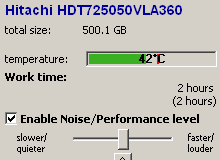
Cache size in top T7K500 and 7K500 models has grown to 16 MB. PATA models from both series as well as some SATA models of the T7K500 series are still equipped with 8 MB buffer. The number of cache memory segments in these drives adaptively changes during operation. According to the manufacturer, it may reach 128 for reading and 63 for writing depending on a task. We can also note that T7K500 offers increased operation shock resistance (up to 70G versus 55G in predecessors) and an increased range of operating temperatures — from 0°C to +60°C. Adding the third platter to Vancouver 5 resulted in: reduced non-operation shock resistance, slightly increased power consumption and idle noise (in three-platter models only) compared to Vancouver 4. But T7K500 seek noise has dropped compared to the other desktop models from Hitachi. It's subjectively very quiet even in Fast Seek mode.
You can read such power consumption specs on Deskstar T7K500 and 7K500 with different interfaces at the following links: T7K500 PATA, T7K500 SATA, 7K500 PATA, 7K500 SATA.
Another important factor is different recording densities in T7K500 models of different capacities. They evidently use 125 GB, 133 GB, 160 GB, and 167 GB platters. It would be logical to assume that 125 GB and 133 GB platters are just 160 GB platters curtailed at edges. But this is not true according to specifications. Platters of different models are indeed formatted to different areal and track density (see Table 2). That is 250 GB models are based on 125 GB platters (recall T7K250), 400 GB models - on 133 GB ones.
| Series and capacity of a model, GB | 250 T7K250 |
500 7K500 |
250 T7K500 |
300 T7K500 |
320 T7K500 |
400 T7K500 |
500 T7K500 |
| Model designations | HDT722525DL | HDS725050KL | HDT725025VL | HDT725030VL | HDT725032VL | HDT725040VL | HDT725050VL |
| Number of platters | 2 |
5 |
2 |
2 |
2 |
3 |
3 |
| Number of heads | 4 |
10 |
4 |
4 |
4 |
6 |
6 |
| Sectors per track | 630-1296 |
594-1242 |
672-1280 |
720-1440 |
720-1440 |
672-1320 |
720-1500 |
| Sectors per cylinder | 2520-5184 |
5940-12420 |
2688-5120 |
2880-5760 |
2880-5760 |
4032-7920 |
4320-9000 |
| Cylinders in a zone | 1810-8341 |
2000-4500 |
1664-7680 |
2432-8960 |
2432-8960 |
1792-8320 |
1792-8832 |
| Number of formatting zones | 30 |
30 |
30 |
30 |
30 |
30 |
30 |
| Areal density - max (Gbits/in2) |
92.1 |
76 |
95 |
113 |
113 |
96 |
118 |
| Data transfer rates (Mbps) | 843.2 |
817 |
824 |
957 |
957 |
848 |
998 |
| Recording density - max (Kbpi) | 767.7 |
720 |
762 |
837 |
837 |
768 |
872 |
| Track density [kTPI] | 120 |
105 |
125 |
135 |
135 |
125 |
135 |
As a result of this approach, T7K500 models (250 GB and 400 GB) are significantly outperformed by 500 GB and even 320 GB models in linear transfer rates - they are similar to 7K500 and T7K250 drives in this respect. In fact, linear recording density and linear access rate in 250 GB and 400 GB Vancouver 5 models are almost 20% lower (!) than in 500 GB models of this series. If you love maximum performance, you should consider 500 GB and 320 GB models of the T7K500 series.
Deskstar T7K500 drives are designed for such applications as personal computers, external storage devices, computers for gamers and enthusiasts, RAIDs for editing video, and even Low duty cycle servers. These hard drives feature Thermal Monitoring and Fly Height Control to improve their operating reliability. Besides, like 7K500/E7K500 drives, they use Advanced Power Management with Low RPM mode, when platters rotate at reduced speed, 4500 rpm instead of 7200 rpm. It takes 4-7 seconds to switch from this low-power mode into idle (depending on a number of platters).
The latest generation of Vancouvers and Kurofunes uses Serial ATA II 3 Gbit/s and UltraATA/133. 7K500 and T7K500 drives support Streaming feature set - these commands optimize HDD operations with streaming data (for example, audio/video). It should be noted that while T7K250 SATA drives come set to 1.5 Gbit/s, T7K500 drives come set to 3.0 Gbit/s. Remember that the interface transfer rate (both parallel and serial — for example, for better compatibility with old hosts) can be changed using Hitachi Feature Tool.

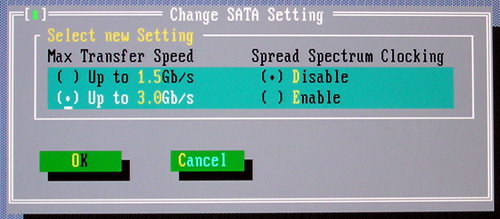
You can also specify the Spread Spectrum Clocking mode here for the SATA interface. After a couple of warnings


and power-off, the utility will change the SATA interface rate. NCQ is not affected. That is NCQ works identically at both interface rates.
We've tested Deskstar T7K500 and 7K500 drives with the default interface rate — at 1.5 Gbit/s with ICH5 controllers (Intel 875P Southbridge) and at 3.0 Gbit/s — with PCI controller SiI3124-2 (but with the PCI32/33 MHz bus that limited the speed at the level of 110 MB/s). We detected no problems in operation of the interfaces.
These drives are manufactured at Hitachi GST plants in Thailand (Code 21xh) and China (Code 31xh). Like 7K500, they are shipped in the traditional proprietary anti-shock package.
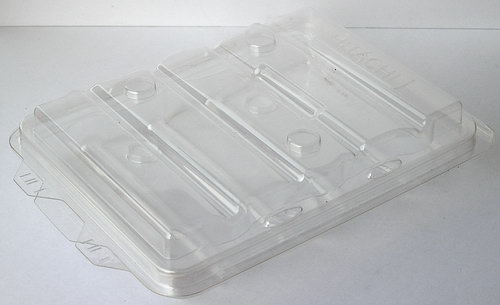
Hitachi GST designations can be decoded using the following instructions:
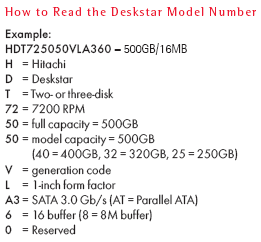
Our contenders and the test procedure here are taken from the recent review of Samsung HD400LJ and HD401LJ drives. Hitachi Deskstar T7K500 was represented by the top model, HDT725050VLA360 (see the label and information about HD Tune) with SATA II interface and 16 MB buffer. Deskstar 7K500 was represented by two samples of the HDS725050KLA360 model (see the label and information on HD Tune) with the same interface and buffer size (results of the two drives will be published for your comparison).
The hard drives were mounted firmly on the metal racks of a chassis and connected to the SiI3124-2 controller (PCI32/33) and ICH5R bridge on the motherboard. Results of hard drives with different controllers are published in different parts of diagrams. The drives were tested with the SiI3124-2 controller in default mode (with NCQ support) and with disabled NCQ (in drivers) on the side of the controller, in order to watch the NCQ effect (good or bad) in this or that task (as well as NCQ drawbacks in these drives).
First of all, we are going to publish linear reading graphs (click on them to see full-size pictures).
|
Hitachi Deskstar T7K500 (500GB)
|
Hitachi T7K250 HDT722525DLA380
|
|
Hitachi Deskstar 7K500, disk 1
|
Hitachi Deskstar 7K500, disk
2
|
|
Hitachi Deskstar 7K400
|
WDC SE16 WD4000KD
|
|
Samsung SpinPoint T133S HD401LJ
|
Samsung SpinPoint T133 HD400LJ
|
|
Seagate NL35 ST3400832NS v5.00
|
Seagate B7200.8 ST3400832AS v3.02
|
As we can see, 100 GB platters of the 7K500 drive with maximum linear read rate of about 65 mln bytes/s (only at the beginning of the disk) barely outperform their 80 GB predecessors from the 7K400 series. They are outperformed by platters of most modern 400 GB drives. On the contrary, 167 GB platters of the top T7K500 model demonstrate excellent linear transfer rates and outperform most modern drives - over 80 mln bytes/s at the outer tracks and "gaining" almost 20% for 125 GB platters in top Hitachi T7K250 models (i.e. for the previous generation of Vancouvers). It has to do with adaptive formatting, of course. Although the zone structure of the graph is still distinct (which cannot be said, for example, about similar drives from Samsung and Seagate). Graphs of the two 7K500 samples match well.
Linear disk write rate graphs plotted in much detail (not accelerated) almost match those for reading (for example, see the HD Tach 3.0.1.0 screenshot).

There are almost no surprises in Serial ATA interface rates:
Hitachi drives demonstrate traditionally best results in their class. However, there is still one surprise — T7K500 and 7K500 evidently drop this speed with the SiI3124 controller in NCQ mode, although WD and Seagate drives do not act like this (Samsung demonstrates the same effect, but it's much weaker). That is it probably has to do with these drives and their NCQ implementation (probably owing to some latencies for processing requests in NCQ mode).
The T7K500 drive demonstrates worse average disk access time (reading) than other drives from this manufacturer, as we expected after reading its specifications. Interestingly, the 7K500 model is also slower than its predecessor here, although it must have retained the 7K400 seek rate. However, Hitachi drives still fare well in this test, although WD and Seagate drives of large capacity are at the back of the pack. In Quiet Seek mode, the T7K500 and 7K500 drives got slower by 5 ms (on the average) in random access.
We can try to judge about the efficiency of firmware procedures of lazy write and caching data for writing by the drop of the average write access time, measured under an operating system, relative to the read access time with enabled write-back caching. For this purpose we use the results of H2benchW and IOmeter.
7K500 drives cache data for random writing much better than the old 7K400 model. It's not surprising considering the doubled cache (though a maximum number of segments to write remains the same). By the way, the T7K250 drive with a twice as small buffer and the same micro-controller also demonstrates similar results here: it's probably the effect of this very processor and firmware algorithms, not the increased buffer. We don't like that two identical 7K500 models (with the same firmware) demonstrate results that differ here by 0.2-0.4 ms. But it's all nothing compared to 500 GB T7K500 model with the same cache size and buffer segmentation as in the 7K500 - its results in this tests are significantly worse than those demonstrated by the 7K500 and even by the 7K400! The only explanation here is the different processor (with proper firmware). Thus, the new T7K500 model is outperformed by its predecessors (7K500 and T7K250) in random access - both read and write - (caching random writing).
The 7K500 drive caches data for writing a tad worse in Quiet Seek mode, while the T7K500 improves its results. That is we again find proof of nonoptimality of algorithms for the new processor in the T7K500 controller. It's completely confirmed by similar tests in Iometer.
Another illustrative test of HDD firmware efficiency is the read/write speed for files of various sizes with various block sizes from 512 bytes to 1 MB. For this purpose we use ATTO Disk Benchmark. The screenshots below display the results for six sizes of a test file — 128 KB, 1 MB, 4 MB, 8 MB, 16 MB, and 32 MB. While the first and the second file sizes are, as a rule, surely cached in the disk buffer (caching read/write data for a 1MB file is not that simple), there is simply no room to fit in the last file size. Caching the other file sizes depends not only on the buffer size, but also on the hard disk firmware.
|
128 KB test file:
|
||
 |
 |
|
|
T7K500 (NCQ)
|
T7K500 (non-NCQ)
|
7K500 (NCQ)
|
|
1 MB test file:
|
||
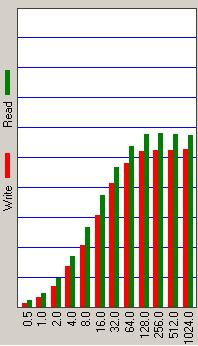 |
 |
|
|
T7K500 (NCQ)
|
T7K500 (non-NCQ)
|
7K500 (NCQ)
|
|
4 MB test file:
|
||
 |
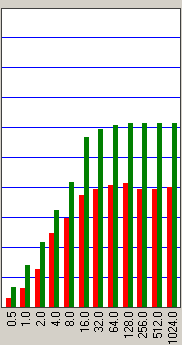 |
|
|
T7K500 (NCQ)
|
T7K500 (non-NCQ)
|
7K500 (NCQ)
|
|
8 MB test file:
|
||
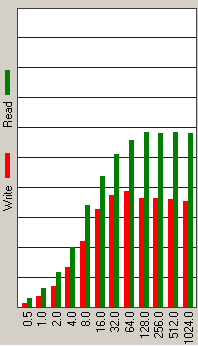 |
 |
|
|
T7K500 (NCQ)
|
T7K500 (non-NCQ)
|
7K500 (NCQ)
|
|
16 MB test file:
|
||
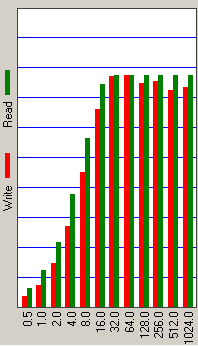 |
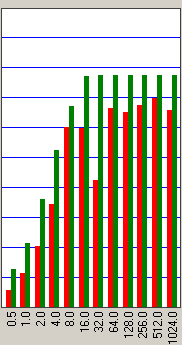 |
|
|
T7K500 (NCQ)
|
T7K500 (non-NCQ)
|
7K500 (NCQ)
|
|
32 MB test file:
|
||
 |
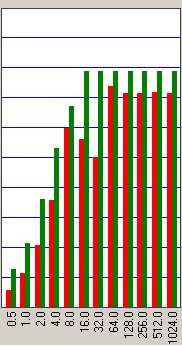 |
|
|
T7K500 (NCQ)
|
T7K500 (non-NCQ)
|
7K500 (NCQ)
|
We can draw the following conclusions from these test results. Firstly, the speed of these drives with 128 KB and 1 MB files is practically identical, SATA models of the T7K500 and 7K500 series demonstrating practically identical performance. Both read and write data are cached identically well. But NCQ results of both drives are a tad worse (especially with small blocks) than when NCQ is disabled on the host side ("no NCQ" results of the 7K500 are published as links under diagrams on the right). Thus, we again found proof of some latencies in these drives demonstrated in NCQ mode (they are most noticeable with small blocks), which slow the overall performance down.
Secondly, 4 MB files are not cached efficiently for writing by these drives (in fact, they are not cached, and the writing rate drops to the level of the physical medium), while caching files for reading is still efficient! Moreover, the 16 MB buffer allows Hitachi T7K500 and 7K500 drives to cache 8 MB files for reading just as efficiently! Although there are no bonuses for writing anymore (unlike some competing drives with the same buffer size). We can again notice that the drives perform a tad better without NCQ (especially with small blocks).
Thirdly, 16 MB files (and larger) are not cached by the drive (HDD performance is determined by the physical medium, that is by the platters). Enabled NCQ is preferable for streaming write, though it still has a negative effect on operations with 512 b - 8 KB blocks and on reading 16 KB blocks.
Let's see how it all affects HDD performance in consumer applications.
First of all, let's see how these drives are optimized for multi-threaded operations. I traditionally use NBench 2.4 tests for this purpose, where 100MB files are written to disk and then read from it in several simultaneous threads — both closely and distantly located on the drive (in this case we used FAT32). The first diagram shows mean results for reading and writing in several patterns.
Hitachi drives hadn't demonstrated brilliant multi-threaded read and write performance before. All the more pleasant to see the new 7K500 drives and especially T7K500 models to get better here. The top 500 GB T7K500 drive does not look awkward compared to high-capacity models from the other manufacturers, although it's outperformed by some of them (see detailed results). Moreover, multi-threaded reading performance of our models under review evidently got better (it mostly has to do with the increased transfer rates of the platters). They are now outperformed only by the best drives from Maxtor and Samsung (see detailed results).
NCQ has a positive effect on multi-threaded read performance of both 500 GB models from Hitachi, but the effect on write performance is not always noticeable. Interestingly, write performance of the 500 GB drives from Hitachi is not affected much by Quiet Seek mode, though reading is noticeably slowed down.
Now let's have a look at how the hard drives fair in old but still popular Disk WinMark 99 tests from the WinBench 99 package. We carry out these tests not only for the beginning but also for the middle part (in terms of capacity) of physical hard drives for two file systems. The diagrams display average results. It should be stressed that in this case the driver of the SiI3124 controller has optimization on the file system. It caches OS accesses and enlarges access blocks, so super-high results of this controller in Business test should not be taken to heart.
T7K500 and 7K500 drives demonstrate practically identical results here (a tad better without NCQ with SiI3124). But in case of the ICH5 controller (it caches less data), the twice as large buffer of the 500 GB models from Hitachi makes itself felt, although a similar drive from Samsung is a tad faster. On the whole, NCQ support is negative rather than positive here, for all drives at that (Hitachi, Samsung, Seagate, WD).
Hitachi T7K500 drive with the 16 MB buffer demonstrates excellent performance in High-End Disk WinMark 99, gaining much versus 7K500. But it's still outperformed by Samsung HD401LJ (only this model).
And now it's time for complex "track" performance tests in PCMark04 and C'T H2BenchW benchmarks.
Doubled buffer helped Hitachi drives set a new performance bar in Futuremark PCMark04 disk test. They outperform even old leaders from WD (however, WD5000KD will be reviewed in a separate article ;)). The difference between T7K500 and 7K500 is minimal in this test. That's another proof of the importance of the 16 MB buffer and disk capacity, as well as the lack of influence of linear transfer rates in this test. High results of these drives in Quiet Seek mode speak of little effect of random access performance on PCmark04, if HDD cache is efficient. NCQ also has a positive effect on Hitachi drives here — the best effect among the Big Four.
Hitachi drives also enjoy a positive effect from the increased buffer in the similar track test C'T H2benchW. They lead in this test, the top T7K500 and 7K500 models demonstrating nearly identical performance, being outperformed only by the WD4000KD without NCQ. By the way, Hitachi drives perform a tad better without NCQ in this complex test.
Adobe Photoshop Swapping Performance appoints a new absolute leader among high-capacity SATA drives: it's the top Hitachi Deskstar T7K500 model - this hard drive significantly outperforms all other competitors including the "perennial" leader from Maxtor. Hitachi 7K500 drives also stand well here, steadily outperforming most competitors. NCQ has almost no effect on Hitachi drives in this test. They practically don't drop performance in Quiet Seek mode: owing to the efficient 16 MB buffer.
We also use special patterns in Intel IOmeter to imitate hard disks operating in various applications. At first — traditional well-spread patterns, offered by Intel and Storagereview.com — DataBase, File Server, Web Server, and Workstation, which mostly characterize professional usage of hard drives in servers and serious workstations.
Unfortunately, Hitachi drives that often took the lead in these server tests, are now outperformed by 400 GB drives from WD and even by Seagate NL35 models of the same capacity. The problem is not only in mediocre access times demonstrated by T7K500 and 7K500, but also in firmware caching algorithms, which evidently lost their purely server optimization. Results of the Web Server pattern (no write operations), where Hitachi drives look better than in the other patterns, show that the situation with random write operations (to be more exact, with caching data for writing, see the tests above) is not that peachy for Hitachi T7K500 drives. Engineers have much to improve. :)
Mean results of these patterns for 4 queue depths (1, 4, 16, and 64) confirm the tendency: the 16 MB buffer has no effect on T7K500 and 7K500 performance in active professional/server operations, because both 7K400 and T7K250 demonstrate better results! In return, NCQ support yields a positive effect here.
Now it's turn for our IOmeter patterns, which are closer to users of regular desktop PCs and near-line applications, though the random character of the disk access in these patterns is adequate to a professional profile as well.
HDD performance does not depend much on QD in the Large File Read/Write test, QD effect even varies sometimes. Nevertheless, NCQ effect is noticeable. It's obviously negative for both 500 GB models from Hitachi in these two patterns. Both Hitachi models are the best at Large File Read without NCQ. And they are outperformed only by WD drives in the Large File Write test.
On the contrary, Small File Read performance of these Hitachi drives favors NCQ support. The 7K500 drive even manages to outperform all its competitors with large QD. 7K500 also performs well in the Small File Write test owing to the NCQ support, while the new and progressive top T7K500 model ranks somewhere in the middle (even with NCQ).
T7K500 copes very well with Large File Copy at random addresses across the entire disk. Its results without NCQ are generally better. And the 7K500 predecessor looks good here as well. These Hitachi drives demonstrate an unusual slump in performance with large QD, which has to do with nonoptimal implementation of NCQ in firmware (there are no slumps without NCQ).
On the contrary, Small File Copy performance gets better owing to NCQ support in Hitachi drives (like in case of Seagate and WD). But the old 7K500 looks evidently better here than the new T7K500 — problems with the new firmware again?
The above mentioned tendencies are illustrated on the diagrams with results, averaged by QD. These diagrams contain pattern results for many other hard drives as well.
If we average HDD results by all six patterns (reading, writing, and copying large and small files),
you will see that the top Hitachi T7K500 model performs very well in this class of tasks, although it's outperformed by the 7K500 from the same manufacturer. This is certainly the best hard drive for these tasks (in general terms, so far). The advantage of both 500 GB drives from Hitachi over the top models from Hitachi T7K250 and 7K400 series is prominent. It justifies manufacturer's efforts to design the new products. ;) NCQ effect on Hitachi T7K500/7K500 drives is mostly negative (you can see it in the diagram).
The defragmentation test confirms the advantage of 7K500 over T7K500. But on the whole, our models under review demonstrate modest results here.
But the situation with Hitachi T7K500 is generally favorable in the pattern of streaming read/write in large or small blocks (e.g. typical of systems for mining, storing, and broadcasting multimedia data in near-line data storage systems and servers, as well as PC or workstation operations when editing video/audio data): its results are over twice as high as those of 7K500 and T7K250 in case of 64 KB blocks, the difference between this drive and 7K400/T7K250 models with 4 KB blocks is nearly tenfold! As a result, T7K500 is currently the best model for such RW operations with 64K blocks. It has even broken the record with 4K blocks of the old leader from Samsung. Considering that the company also uses T7K500 as a basis for the C7K500 series for multimedia and consumer applications, such improvements in streaming operations and firmware optimizations are only welcome!
So, Hitachi has launched its first (7K500) and second (T7K500) 500 GB HDD models with 16 MB buffer. They are attractive products offering good performance and high capacity. Out of doubt, both products are outstanding, even innovative in some respects. But these products have left mixed feelings. On one hand, Vancouver 5 (T7K500) offers the highest transfer rates and 167 GB platters, and Kurofune 2 (7K500) has a "unique" 5-platter design, which will be used in a terabyte hard drive to be launched by Hitachi soon. ;) But the increased recording density also has negative effects: T7K500's random read rate remains (even in specifications) a tad worse than in its predecessors and 7K500. On one hand, the improved controllers of T7K500/7K500-series drives are equipped not only with 16 MB of cache (instead of 8), but also with a new processor (for T7K500). And the optimized firmware allows these drives to become absolute performance leaders in a number of desktop and multimedia applications. On the other hand, some obscure changes in firmware (especially in T7K500) make them lose the competition even with their predecessors in some professional (and not only them) applications. Besides, we have several serious questions about the value of NCQ in these drives. We can hope that developers will fix the bugs in the new firmware versions for T7K500, of course. But I think that the situation will not be changed cardinally anyway. Deskstar T7K500 is to replace the popular Hitachi Deskstar T7K250 series. It will be popular only in those (desktop) segments, where it performs rather well and where old fans of IBM Vancouvers are happy with another worthy (but still not all-purpose) and certainly the best representative (like in better years :)).
Write a comment below. No registration needed!
|
Article navigation: |
| blog comments powered by Disqus |
| Most Popular Reviews | More RSS |
 |
Comparing old, cheap solutions from AMD with new, budget offerings from Intel.
February 1, 2013 · Processor Roundups |
 |
Inno3D GeForce GTX 670 iChill, Inno3D GeForce GTX 660 Ti Graphics Cards A couple of mid-range adapters with original cooling systems.
January 30, 2013 · Video cards: NVIDIA GPUs |
 |
Creative Sound Blaster X-Fi Surround 5.1 An external X-Fi solution in tests.
September 9, 2008 · Sound Cards |
 |
The first worthwhile Piledriver CPU.
September 11, 2012 · Processors: AMD |
 |
Consumed Power, Energy Consumption: Ivy Bridge vs. Sandy Bridge Trying out the new method.
September 18, 2012 · Processors: Intel |
| Latest Reviews | More RSS |
 |
Retested all graphics cards with the new drivers.
Oct 18, 2013 · 3Digests
|
 |
Added new benchmarks: BioShock Infinite and Metro: Last Light.
Sep 06, 2013 · 3Digests
|
 |
Added the test results of NVIDIA GeForce GTX 760 and AMD Radeon HD 7730.
Aug 05, 2013 · 3Digests
|
 |
Gainward GeForce GTX 650 Ti BOOST 2GB Golden Sample Graphics Card An excellent hybrid of GeForce GTX 650 Ti and GeForce GTX 660.
Jun 24, 2013 · Video cards: NVIDIA GPUs
|
 |
Added the test results of NVIDIA GeForce GTX 770/780.
Jun 03, 2013 · 3Digests
|
| Latest News | More RSS |
Platform · Video · Multimedia · Mobile · Other || About us & Privacy policy · Twitter · Facebook
Copyright © Byrds Research & Publishing, Ltd., 1997–2011. All rights reserved.